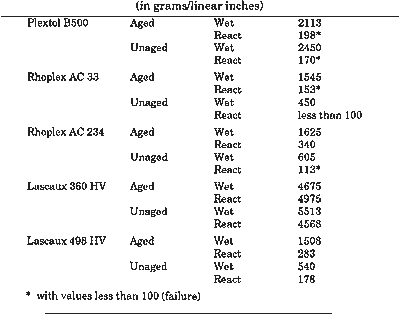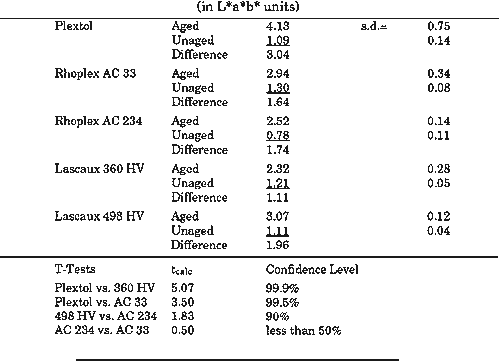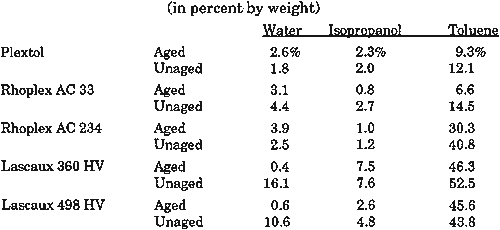A STUDY OF ACRYLIC DISPERSIONS USED IN THE TREATMENT OF PAINTINGS
Michael C. Duffy
5 RESULTS
5.1 Aging Results
AFTER MORE THAN 100 HOURS IN THE CHAMBER, the cast films showed slight yellowing. The polyester fabric of the lining samples was yellowed as well, but the adhesive sandwiched in between remained clear. Since light and thermal aging were occurring simultaneously, it is hard to say which was the cause of yellowing. It may be significant, however, that the adhesives exposed to light and heat did discolor while those exposed to heat only did not. Lengthier exposure would have certainly caused more significant differences in discoloration among the samples. No measurable differences in flexibility could be discerned between the aged and unaged samples. All were extremely flexible before and after aging took place.
5.2 Peel Strengths
Some significant trends emerge from the peel strength test data. Average values for the peel strengths of each sample type were calculated from the Scott Tester charts (see table 1). Representative charts from each sample type were chosen for evaluation. Random high and low points were chosen, and an overall average value was attained. Some peel tests gave uneven results, probably because of bubble inclusions in the dried dispersion or unevenness in application that were not apparent during sample preparation. The slightly ribbed texture of the sailcloth fabric was also a factor contributing to variable adhesion. For practical considerations, peel strengths of under 100 grams were considered failures.
Table 1. Peel Strength Values
Peel Strength Values
 |
Differences in peel strengths after aging were most apparent with the Rhoplex films. Aged samples of both wet laminate and reactivated samples had higher peel strengths than unaged samples. This result may indicate a degree of polymer cross-linking that occurred after exposure to heat and light. Moreover, the excessive heat of the chamber, sometimes exceeding the Tg of the samples, may have caused a more tenacious bond. The solvent reactivated samples of AC 33 failed across the board, although the aged samples had slightly higher peel strengths. When used as a wet laminate, the AC 33 held more tenaciously, giving peel strengths of about 450 grams in the unaged samples and about 1,545 grams in the aged samples. AC 234 had slightly higher peel strengths in the wet laminate samples but failed in the reactivated category. AC 234 wet laminate samples had much higher (+1020) values than their unaged counterparts.
Aging also caused higher peel strengths in the 498 HV samples. There was about a 1,000 g higher average peel strength for the aged wet samples for this adhesive. Reactivated unaged samples came close to failing, while the aged reactivated samples had slightly higher peel strengths (about +100 g). This adhesive performed much like the Rhoplexes in peel tests.
The most consistent peel strength values were given by the 360 HV, with very high peel strengths in all categories. There was very little change in values between aged and unaged samples or even between wet and reactivated samples. This result may be explained by the fact that the 360 HV remains tacky when dry and bonds readily to most surfaces. Even the reactivated lining samples formed tenacious bonds with values two to four times higher than those of the other adhesives.
Plextol also gave similar values in the aged and unaged categories, differing only by 300 g or so. The reactivated samples, however, failed in both the aged and unaged trials. Of the five adhesives, the Plextol B500 performed the most consistently between aged and unaged samples without the high bonding of the 360 HV.
5.3 Color Change
To compare changes in color, the L*; a*; b*; system of the Minolta Chroma Meter was used. Chroma (b*;) values were chosen for statistical analysis because increases in this number correspond to an increase in yellowing of the sample. Six measurements were taken, and their averages and standard deviations were calculated (see table 2). Confidence levels were established for comparison of selected groups of data. The degree of freedom equaled 10 for the two sets of six samples.
Table 2. Chroma (b*;) Values
Chroma (b*;) Values
 |
Of the five samples tested, Plextol had the most discoloration, with a difference of 3.04 units between aged and unaged samples. Lascaux 360 HV had the least discoloration, with only a 1.11 difference in Chroma values. Comparison of these two values using the T-Test established that they differed in discoloration significantly, measurable at the 99.9% confidence level. Other discoloration values could not be distinguished from each other at that level of confidence. Comparison of the Rhoplex AC 33 and AC 234 values yielded a less than 50% confidence level. It should be noted that although these are measurable differences, the degree of yellowing appeared to the eye to be about the same for all adhesive samples—the Plextol was not noticeably more discolored than the others. Aged and unaged samples could easily be distinguished, however.
5.4 Percent Swelling
With the addition of water the film samples swelled slightly, turning white and opaque. Swelling in the unaged samples of 360 HV and 498 HV was significantly greater (16% and 10% respectively) than for the aged samples (0.4% and 0.6%), suggesting that aged films are much less permeable to moisture than young films (see table 3). Swelling with water alone would not reverse a polymer film.
Table 3. Swelling Values
Swelling Values
 |
Percent swelling of the films in isopropanol was also very small. The samples became semi-opaque with the addition of this solvent. The greatest amount of swelling occurred in the aged and unaged 360 HV samples at around 7.5%. Unaged 498 HV swelled to about 5%, while values for all the others were under 3%. What was surprising was that, on average, greater swelling occurred in distilled water than in isopropanol.
The addition of toluene to the films caused them to swell completely and dissolve into a clear gel. For the most part, unaged samples swelled at a higher percentage than aged films. The least swelling occurred in Plextol and AC 33 films, while swelling of the AC 234, 360 HV, and 498 HV was especially high—in the 30%–50% range.
|